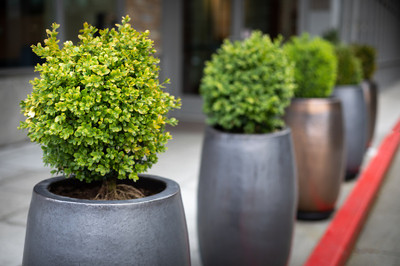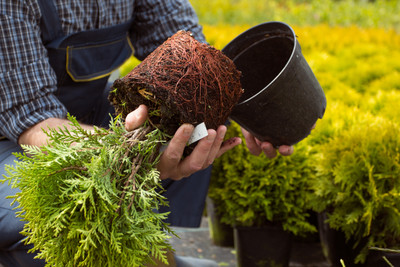Creative Landscape Ideas for Small Spaces: Make the Most of Every Inch
Posted by Jason Wyrwicz on Oct 1st 2025
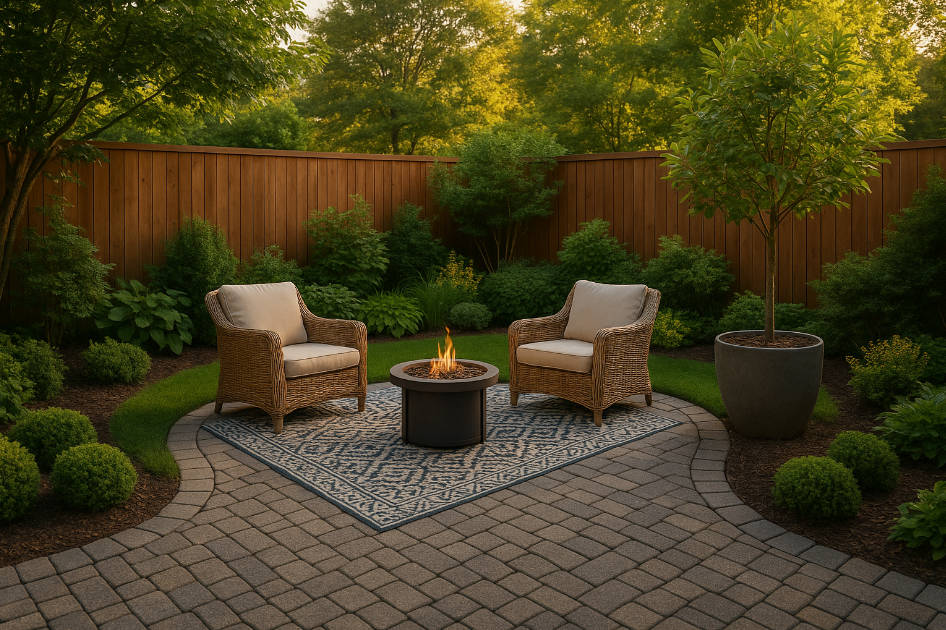
Small patios, balconies, and tiny yards can appear larger with the right plants, finishes, and visual tricks.
Small-space landscaping combines comfort, low-maintenance upkeep, and even a dash of sustainability into areas many people overlook.
The ideas below provide you with ready-to-use tactics, drawn from designers, growers, and real-life “tight yard” owners, that transform cramped corners into inviting outdoor rooms. You’ll see landscape ideas for small spaces, color tips, plant pairings, and smart layouts you can start this weekend.
Plan with Purpose
Start by asking the big question: “What’s the main job of this space?”
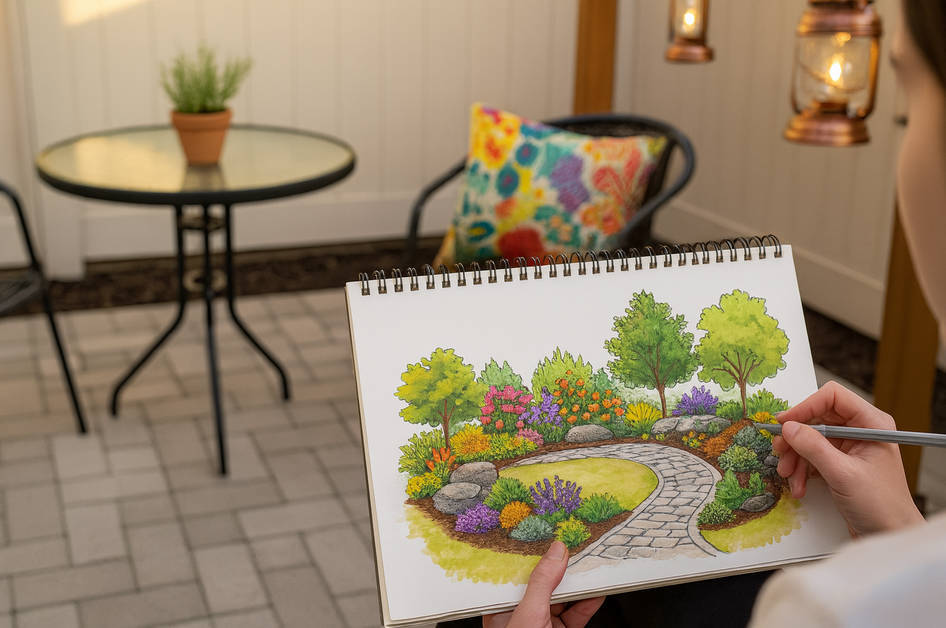
A small yard or balcony can transform from being cluttered to a streamlined, inviting oasis once its core use is crystal clear. For example, lounging with a book, grilling for two, or keeping fresh basil by the back door.
After you’ve nailed that anchor use, stick to three or four headline elements. Anything more feels busy and makes the footprint feel smaller.
Purpose Checklist
- Daily routine – Do I crave a sunrise coffee nook, a spot to stretch after work, or an herb shelf near the kitchen?
- Who’s coming – Will this patio host kids, pets, or friends, and how many can fit at once?
- Must-have zones – Seating, cooking, a daybed corner, or a tabletop fire bowl - what stays no matter what?
- Maintenance time – Am I happy pruning once a week, or do I need plants that coast on rain alone?
- Storage hideaways – Where will cushions, tools, or folding chairs tuck away during rain or winter?
Write your answers in one column, then circle the essentials. Let that short list steer every design pick, plants, pavers, and décor, so each square foot serves the life you’ll live out there.
Maximize Vertical Real Estate
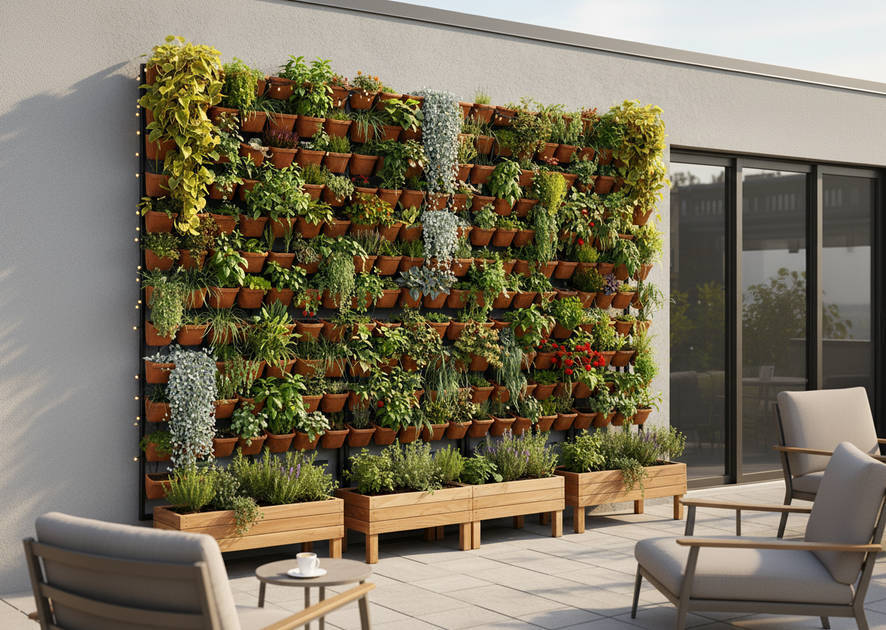
When floor space is limited, consider using walls, rails, and overhead beams. Wall-mounted planters tuck strawberries, mint, or trailing pothos into unused vertical strips.
A cedar ladder shelf, stacked with terracotta pots, keeps rosemary, oregano, and thyme within arm’s reach while freeing up the ground for seating.
Hanging baskets help, too. Try trailing fuchsia in the summer, then swap it in with hardy ivy come fall. If you crave statement color, a black planter on a pale wall makes silver dichondra leaves pop at eye level.
Powder-coated steel trellises also turn blank fences into living mosaics once you thread climbing beans, star jasmine, or dwarf passionfruit vines through the grid.
Pro tip: Lining planters with coconut fiber allows water to drain quickly, reducing the risk of root rot and trimming upkeep time.
Define Zones & Focal Points
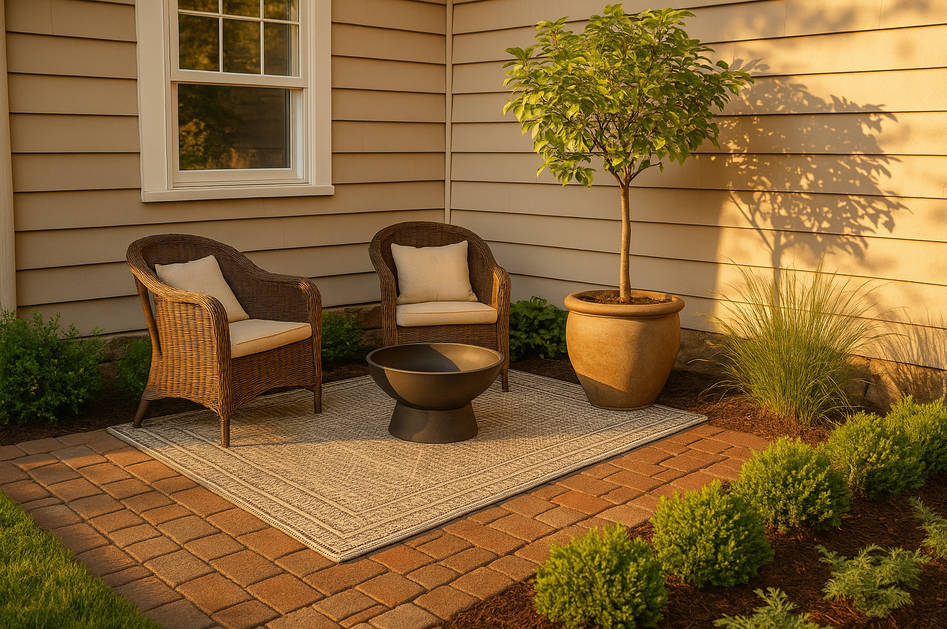
Even a five-by-eight-foot patio benefits from zones. Lay a recycled-plastic rug under two café chairs to mark a chat corner. A short stack of weather-proof cushions doubles as extra seating and a color accent. In front yards, low hedging can create a pocket garden without obstructing street views.
Pick one standout piece to hold attention. It might be a tall red planter filled with dwarf bamboo, a bubbling basalt bowl, or a sculptural steel orb that glints under evening lights. Keep supporting décor simple so the star element shines and the space feels larger.
Use Light & Reflection
Light tricks the eye, which works in your favor when square footage runs lean. Pale pavers, crushed oyster shell, or ivory pea gravel bounce sunshine back into the scene and keep summer afternoons cooler underfoot.
A cedar-framed, shatter-proof mirror on the fence multiplies every leaf it catches, doubling perceived depth and adding a bit of sparkle.
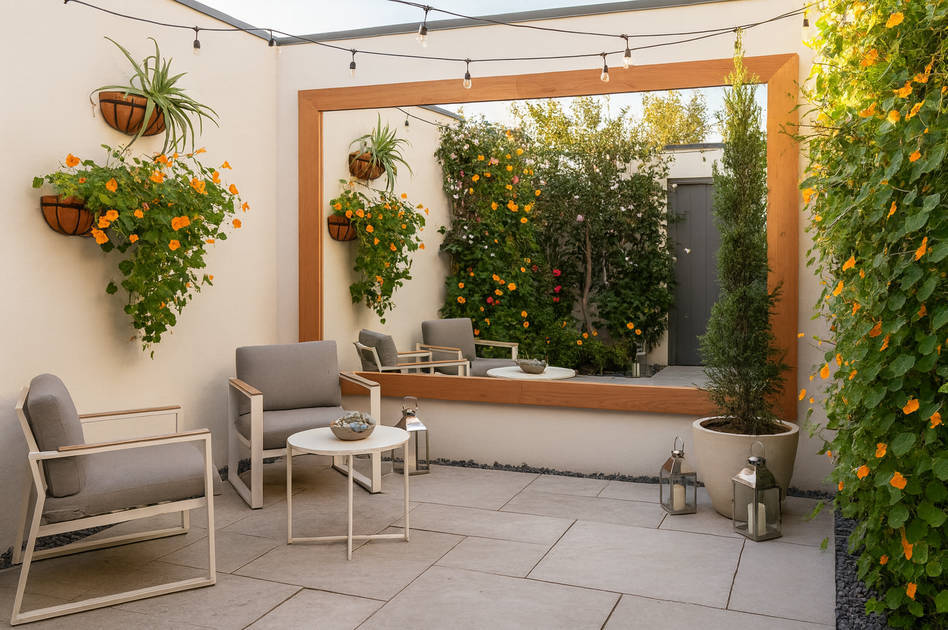
Small reflective accents amplify the trick. A glass tabletop flashes a sky-blue hue, and stainless-steel lanterns throw pinpoints of brightness along a path. Even a copper watering can on a bench gives off warm glints, creating the illusion of extra breathing room.
When dusk settles, plug in warm-white LED strings or tuck solar uplights behind planters; their glow outlines the perimeter, guides the eye upward, and makes the whole space feel taller.
If you want to add another dynamic element, add water. A slim wall fountain or a shallow bowl filled with river stones mirrors cloud shapes by day and candlelight by night.
The ripples bounce low-key reflections across nearby walls, creating movement and soft sound that distract from tight borders. Pair the fountain with light-toned hardscape and you’ll stretch visual boundaries even further.
Smart Hardscaping & Groundcover
Hardscape anchors every successful small yard. Opt for permeable materials, such as decomposed granite or brick laid on sand, to allow rainwater to drain instead of pooling. Narrow paths, around eighteen inches wide, guide movement without eating precious square footage.
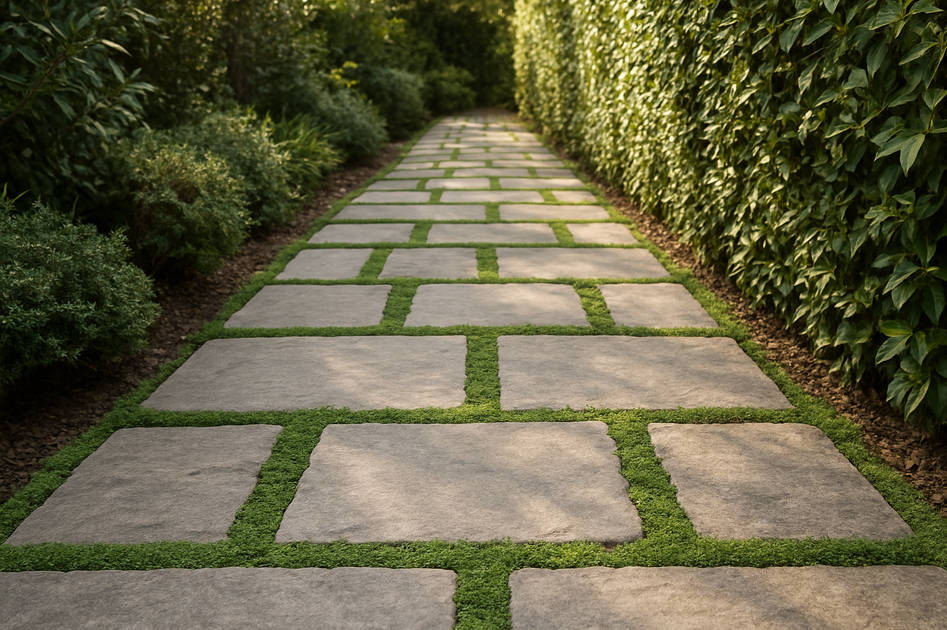
Slip low-growing groundcovers between stepping-stones for color and scent. Creeping thyme releases aroma with each footfall, while dwarf mondo grass stays tidy under patio chairs. If you favor a modern look, use rectilinear concrete pavers and brush joints with fine gravel for a crisp, grid pattern.
Layer with Color & Texture
Depth starts with smart stacking. Picture the space in thirds, ground, middle, and sky, and build each level with plants that contrast in hue and feel.
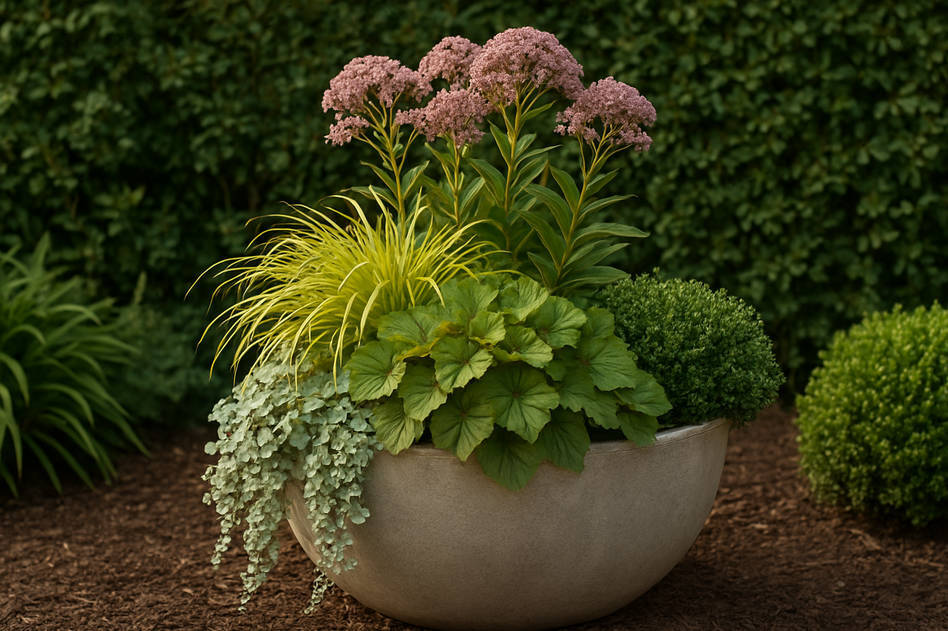
- Ground layer – woolly thyme, blue star creeper, or dwarf sedum spreads like a soft carpet and hides bare soil.
- Mid-layer – rounded dwarf boxwood, fragrant lavender, or richly veined coral bells anchor the scene and bridge low to high.
- Tall layer – upright feather reed grass, slender columnar juniper, or a potted Meyer lemon lifts the eye and frames the backdrop.
Now dial up visual appeal with texture. Set rusty corten steel edging against glossy magnolia leaves for a warm, rough-meets-sleek combo.
Place a smooth charcoal planter near feathery Mexican feather grass so the contrast pops. Drop flashes of bloom, such as calendula, dwarf zinnia, and red geranium, along sight lines to guide attention and make the garden feel longer than its tape measure suggests.
Also, use color pairings that work, such as:
- Slate pot + chartreuse sweet potato vine
- White planter + purple basil
- Burnt-orange bowl + blue fescue clumps
Each duo delivers high contrast without overpowering the scene, letting your small space read as lively yet refined.
Eco-Smart Planting
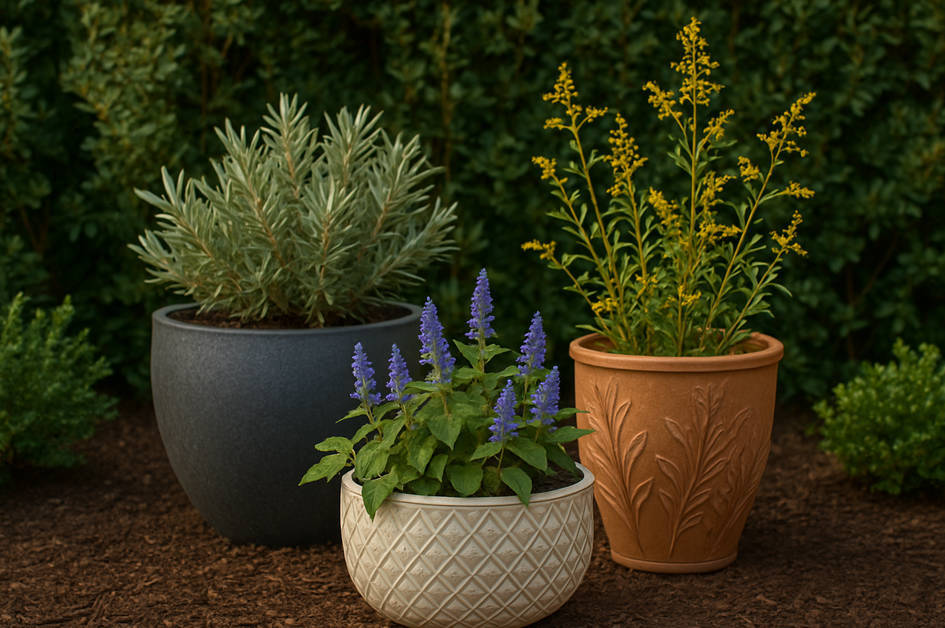
Drought-tolerant staples like agave, echinacea, and kangaroo paw thrive on scant water and resist most pests. Native shrubs adapt quickly to local soil and climate, reducing the need for fertilizer.
Group plants with the same thirst level so you don’t drown one while rescuing another. Swap traditional turf for clover or mini-clover blends; they stay green, need little mowing, and feed pollinators. Blanket bare soil with shredded bark to lock in moisture and knock down weeds.
You can also try collecting rain where you can and let gravity handle the watering. A slim barrel tucked under a downspout fills quickly during a summer storm and replenishes containers during dry spells. Pair it with a simple drip line so every drop reaches the roots, not the patio.
Permeable pavers, teamed with a shallow swale, pull runoff toward thirsty beds, keeping precious moisture on-site instead of washing it down the gutter.
Edible & Ornamental Together
Foodscaping turns every pot or border into a versatile feature; it’s lush to look at, and tasty when harvest time rolls around. Slip herbs and dwarf peppers among colorful daisies, or let purple kale back a row of bright marigolds.
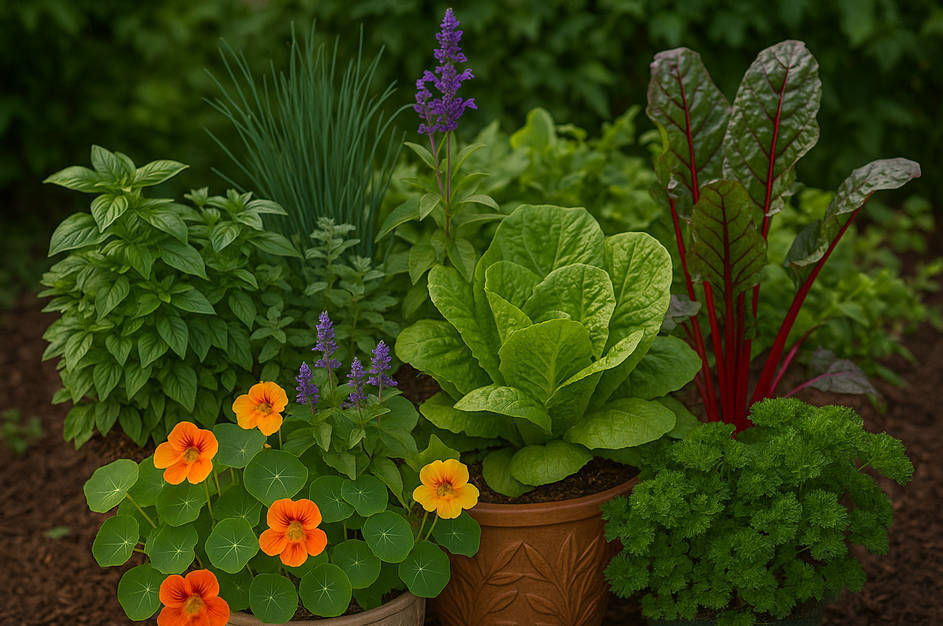
Raised cedar beds and sleek fiberglass planters keep soil deep and warm, while their clean lines add structure to tight patios. When space is limited, vertical frames support pole beans and scarlet runner vines, freeing the ground beneath for salad greens.
A mixed planting attracts pollinators, provides quick snips for the kitchen, and delivers nonstop color. Soft basil leaves offset spiky chives; glossy strawberries spill over the rim of a charcoal planter; golden nasturtiums trail like living garlands. Each combination earns its keep with fragrance, foliage contrast, and a steady flow of edible rewards.
Use this quick cheat-sheet to match your goal with smart plant combos and see, at a glance, why each pairing works.
|
Goal |
Plant Ideas |
Why It Works |
|
Easy Care |
Lavender, aloe, succulents |
Low water needs and strong disease resistance |
|
Vertical Growth |
Pole beans, sugar-snap peas, ivy |
Uses trellises to clear floor space |
|
Edible Beauty |
Basil, nasturtiums, dwarf peppers |
Bright leaves and blooms plus a practical crop |
Group crops by watering habits and sun demand to simplify maintenance. Tuck a drip line through the bed, mulch the surface to retain moisture, and let the plants fill in the gaps over time.
By doing this, you’ll get a compact garden that feeds both the eyes and the plate, all without sacrificing style.
Add Personality & Finishing Touches
Light sets the mood. Stake solar lanterns along a path, drape warm-white string lights under the eaves, or aim a low-voltage spotlight at a potted olive tree. The gentle glow allows you to linger outdoors after dark, revealing textures that daylight often hides.
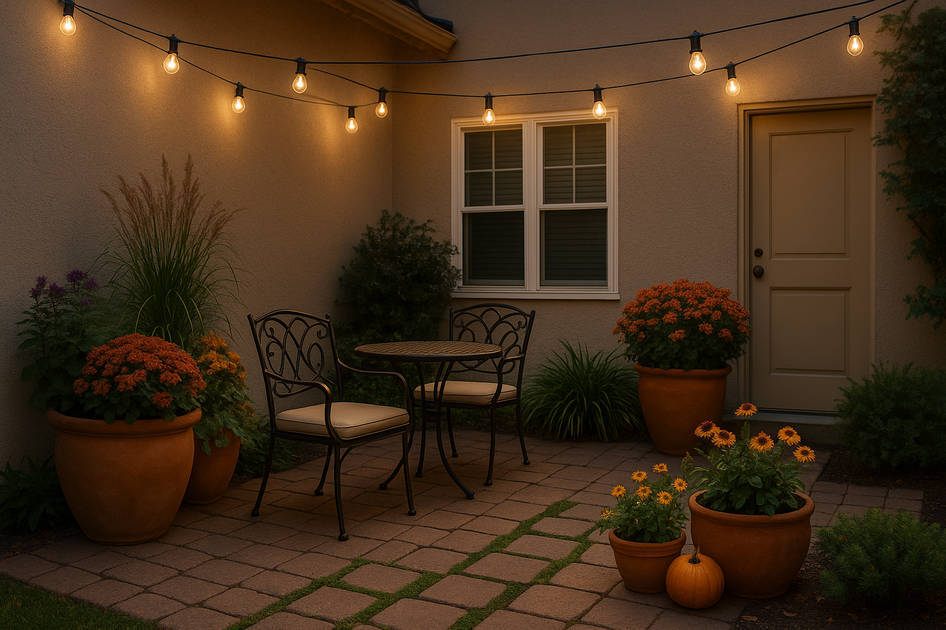
Colorful cushions, quirky planters, and a shallow birdbath add character while drawing birds that animate quiet mornings.
Swap accents with the seasons, like lemon-yellow pillows in summer, burnt orange in autumn; coral mums in late summer, and dwarf conifers and red berries once the chill sets in.
These quick tweaks refresh the space without a full redesign, so the garden always feels current and ready for any gathering.
In Summary
You now hold a full toolbox of landscape ideas for small spaces, ranging from sky-reaching trellises and clever mirror placement to layered color schemes and beds that mix food crops with flowers.
Try one tactic at a time: hang a trio of wall planters, replace a narrow strip of turf with a thyme patch, or frame a seating nook with string lights and dwarf bamboo. Each small change builds a patio, balcony, or side yard that feels richer, roomier, and simpler to maintain.
Last but not least, keep experimenting! Adjust plant groups to match local rainfall, switch cushions when seasons change, and rotate pots to showcase new textures. Your outdoor nook will keep growing with you, bringing more flavor for the kitchen, more blooms for the bees, and more calm at day’s end.
For fresh inspiration and an easy starting point, browse our modern planters to transform your small space today.


